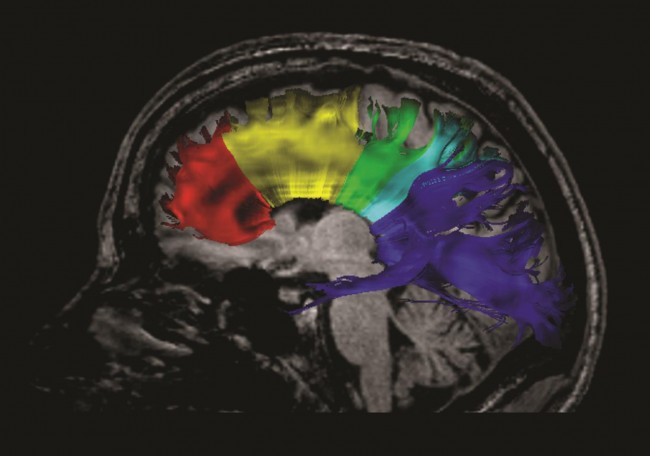Former NFL Players Who Started to Play Tackle Football Before Age 12 May Experience Altered Brain Development
New insight into the evolution of chronic traumatic encephalopathy (CTE) may have been discovered by BUSM researchers. Repeated head trauma prior to a critical age dependent window may potentiate the risk of progression of chronic traumatic encephalopathy.
Former National Football League (NFL) players who started playing tackle football before the age of 12 were found to have a higher risk of altered brain development compared to those who started playing at a later age. The study which appears in Journal of Neurotrauma, is the first to demonstrate a link between early exposure to repetitive head impacts and later life structural brain changes.
 Tractography of the corpus callosum. The corpus callosum was subdivided into five regions containing commissural fibers of prefrontal (region I), premotor and supplementary motor (region II), primary motor (region III), sensory (region IV), and parietal, temporal and occipital cortical areas (region V). 70 Tracts were obtained using deterministic (streamline) tractography to trace fiber paths through the regions of interest
Tractography of the corpus callosum. The corpus callosum was subdivided into five regions containing commissural fibers of prefrontal (region I), premotor and supplementary motor (region II), primary motor (region III), sensory (region IV), and parietal, temporal and occipital cortical areas (region V). 70 Tracts were obtained using deterministic (streamline) tractography to trace fiber paths through the regions of interest
The researchers examined 40 former NFL players between the ages of 40-65 who had more than 12 years of organized football participation, with at least two years at the NFL level. Half of the players participated in tackle football before the age of 12 and half began at age 12 or later. The number of concussions sustained was similar between the two groups. All of these players experienced at least six months of memory and thinking problems.
To examine brain development in these players, the researchers used an advanced technique called diffusor tensor imaging (DTI), a type of magnetic resonance imaging that specifically looks at the movement of water molecules along white matter tracts, which are the super-highways within the brain for relaying commands and information. The results showed that the research participants who started playing football before age 12 were more likely to have alterations of the white matter tracts of the corpus callosum, the largest structure of the brain that connects the two cerebral hemispheres.
According to the researchers there is growing evidence that there is a “critical window” of brain development between ages 10-12, when the brain may be especially susceptible to injury. While the study shows there may be a neurodevelopmental window susceptible to repeated head impacts, such as those experienced playing tackle football, the authors underscore the fact that this is a small study with just 40 individuals, and results cannot be generalized to individuals who did not go on to play professional football.
This study was conducted as part of the Diagnosing and Evaluating Chronic Traumatic Encephalopathy using Clinical Tests (DETECT) project, funded by the National Institutes of Health, under the leadership of Robert Stern, PhD, professor and director of the Boston University Alzheimer’s Disease and CTE Center’s Clinical Core. Stern, who is corresponding author on this publication, cautions that, “these abnormal neuroimaging findings are not necessarily indicative of chronic traumatic encephalopathy or CTE,” referring to the neurodegenerative disease that is associated with a history of repetitive head impacts and has been diagnosed post-mortem in numerous former football players. “While this study adds to the growing concern that exposing children to repetitive hits to the head in tackle football may have long lasting consequences, there are likely other contributing factors that contribute to overall risk for CTE,” added Stern.
Previous research by the same investigators showed that there was a difference in former NFL players’ cognitive functions depending on whether they started playing before or after age 12, with the former group at a higher risk of developing mood, behavioral or cognitive impairment later in life. In both studies, the authors caution that more investigation into later-life consequences of childhood exposure to repetitive head impacts is necessary, and that the ultimate goal is to increase safety in youth sports, thus allowing young athletes to take advantage of the tremendous benefits of sports participation without increased risk of long-term negative health consequences.
Submitted by Brian Smerkers, MD.
View all posts